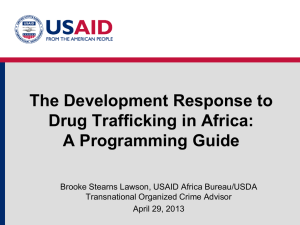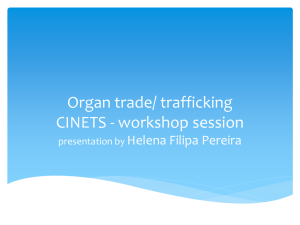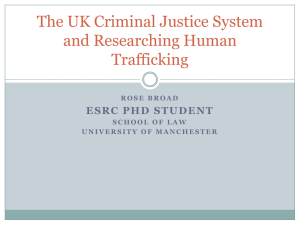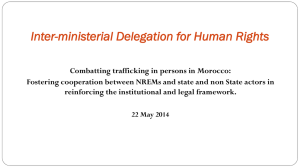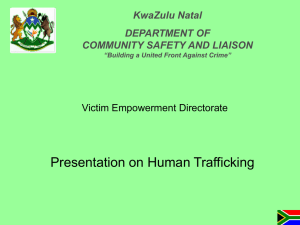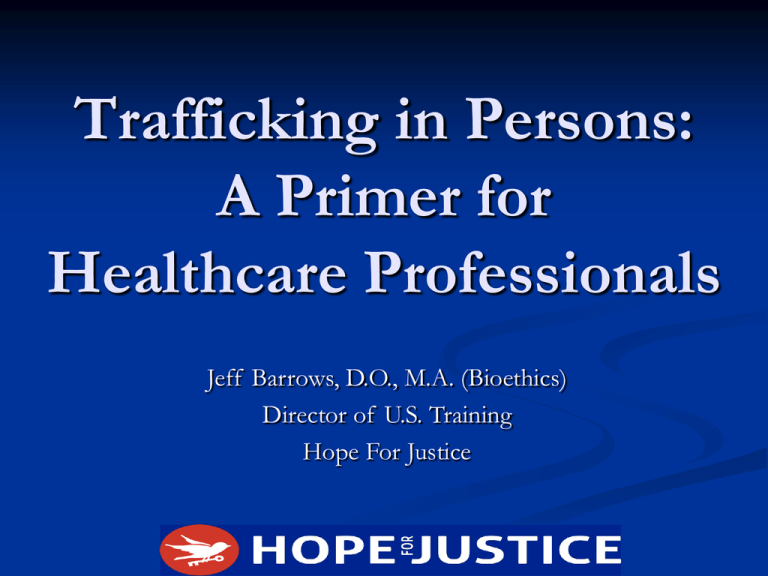
Trafficking in Persons:
A Primer for
Healthcare Professionals
Jeff Barrows, D.O., M.A. (Bioethics)
Director of U.S. Training
Hope For Justice
Disclosure Information
Trafficking in Persons: A Primer for Healthcare Professionals
Dr. Jeff Barrows
I have no financial relationship to disclose.
AND
I will not discuss off label use and/or
investigational use in my presentation.
Educational Objectives
At the conclusion of this program, participants
should be able to:
Describe the scope and general characteristics of
human trafficking in the U.S.
Recognize the common indicators and high-risk factors
for human trafficking
Evaluate and assess whether a patient is a victim of
human trafficking
Human Trafficking:
Legal Definition
Derived from federal legislation entitled:
The Trafficking Victims Protection
Act of 2000
TVPA
United States- TVPA
To be convicted of HT
Action:
Means:
Purpose:
Recruiting
Harboring
Transporting
Obtaining
Exploiting
Force
Fraud
Coercion
Sexual
Exploitation
OR
Labor
Exploitation
One Exception:
Minor <18 in commercial sex
Action:
Means:
Purpose:
Recruiting
Harboring
Transporting
Obtaining
Exploiting
Force
Fraud
Coercion
Sexual
Exploitation
Human
Trafficking
Sexual
Exploitation
Labor
Exploitation
Human
Trafficking
Sex
Trafficking
Labor
Trafficking
Human
Trafficking
International
Victims
Domestic
Victims
Human
Trafficking
International
Victims
Sex
Trafficking
Labor
Trafficking
Domestic
Victims
Sex
Trafficking
Labor
Trafficking
Human
Trafficking
International
Victims
Sex
Trafficking
Labor
Trafficking
Domestic
Victims
Sex
Trafficking
Labor
Trafficking
In 2012 TIP Report taken from 2012 ILO Report on Forced Labor; available online at:
http://www.ilo.org/sapfl/Informationresources/ILOPublications/WCMS_182004/lang-en/index.htm
Worldwide Scope of Trafficking
State Imposed
Forced Labor
2,200,000
Female
55%
Male
45%
Sexual
Exploita on
4,500,000
Labor
Exploita on
14,200,000
Minor
26%
Adult
74%
In 2012 TIP Report taken from 2012 ILO Report on Forced Labor; available online at:
http://www.ilo.org/sapfl/Informationresources/ILOPublications/WCMS_182004/lang--en/index.htm
International Trafficking
within the U.S.
U.S. Estimate
Location of Potential Trafficking Cases
“Human Trafficking Trends in the U.S.” National Human
Trafficking Resource Center 2007-2012.
International Sex Trafficking Venues:
Strip/topless clubs
Asian massage parlors
Online escorts
Latino brothels
Major sporting events
International labor trafficking venues:
Domestic servants
Sweatshops
Factories
Janitorial jobs
Construction sites
Restaurants
Hotels
Farm work
International Traffickers:
The Profile
Sophisticated
National, international
networks
Organized crime
syndicates
Domestic Trafficking
Trafficking of U.S. Citizens
Domestic Trafficking
Domestic Sex Trafficking Venues:
Street prostitution
Strip/topless clubs
Massage parlors
Online escorts
Truck stops
Major sporting events
Domestic Minor Sex Trafficking
American teenagers who
runaway to escape abuse
in their homes
Often end up in
prostitution
Girls as young as 12-14
years old caught in
prostitution
Vulnerable Youth
Physically abused
Sexually abused
Neglected
Abandoned
Youth of all races and
socioeconomic strata
So why is this such a
HUGE problem?
Money!
Average girl will make between $500 to
$1000 per day selling sex
Who are the traffickers?
Homelessness, Survival Sex and Human Trafficking: As Experienced by the Youth of
Covenant House New York
May 2013
Recruitment- Gorilla Pimp
Tricks the girl into
coming with him
through lies
Uses brutal force and
threats to control her
Less common type of
trafficker
Recruitment- Finesse Pimp
Stage 1-Initial Contact
Internet
Malls
Stage 2- Seduction
Stage 3- Increasing control
Stage 4- Separation
Stage 5- Trauma bonding
“You promise a girl
heaven, and she’ll
follow you to hell”
Quote from a trafficker
Where are the girls/women sold?
Internet
Backpage
Craig’s List
Eros.com
Facebook
My Space
Messaging services
Backpage
Male Victims
Under-recognized
Victims of both labor
and sex trafficking
Commercially exploited
males are perceived as
less likely to be under the
control of a trafficker
Role of
Healthcare
Professionals
Finding and Caring for victims of
human trafficking
International Sex Trafficking and Healthcare
Interviewed survivors and workers in LA
All survivors of international trafficking into
U.S.
50% had visited a healthcare professional while
in captivity
None were freed as a result of the encounter
Baldwin, SB, Eisenman DP, Sayles JN et al. “Identification of Human
Trafficking Victims in Healthcare Settings”. Health and Human Rights (2011)
(13) 1:1-14.
Domestic Sex Trafficking and Healthcare
87.8% of victims interviewed reported contact
with healthcare system!
Lederer, L. and Wetzel, C.A. “The Health Consequences of
Sex Trafficking and Their Implications for Identifying
Victims in Healthcare Facilities”. (2014) The Annals of
Health Law 23:1. 61-91.
Where victims are seen
for healthcare
Hospital/Emergency rooms- 63%
Planned parenthood- 30%
Family physician- 23%
Urgent Care Clinic- 21%
Women’s clinic- 19%
Neighborhood clinic- 19%
Lederer, L. and Wetzel, C.A. “The Health Consequences of
Sex Trafficking and Their Implications for Identifying
Victims in Healthcare Facilities”. (2014) The Annals of
Health Law 23:1. 61-91.
Sexually Exploited Youth
77% of youth identified as sexually exploited in
Oakland CA stated that they see a physician
regularly
33% are currently on prescribed medications
49% had been hospitalized
Missey Data Report- June 2009; available online at:
http://www.misssey.org/documents/data_report_final.pdf
ED Personnel knowledge
of trafficking
Assessed knowledge among ER personnel in 4
large emergency rooms in the NE
Never had formal training on trafficking- 98%
Knew what trafficking was- 74%
Defining TIP
19% were confident in ability to define TIP
80% were hesitant to define TIP
6% had treated a victim of trafficking
Chisholm-Straker, M., Richardson, LD., and Cossio, T. “Combating Slavery in the 21st century: The role
of emergency medicine.” (2012) J Healthcare for Poor and Underserved 23:980-987.
ED Personnel knowledge
of trafficking
Whether HT was a problem in their ER:
27% yes
7% no
59% unsure
Confident in ability to identify a victim of
trafficking- 5%
Confident in ability to treat a victim of trafficking7%
Chisholm-Straker, M., Richardson, LD., and Cossio, T. “Combating Slavery in the 21st century: The role
of emergency medicine.” (2012) J Healthcare for Poor and Underserved 23:980-987.
ED Personnel knowledge
of trafficking
Results after taking 20 min training program:
90% were confident in ability to define TIP
54% were confident in ability to identify a victim of
trafficking
57% were confident in ability to treat a victim of
trafficking
93% said session was useful
Chisholm-Straker, M., Richardson, LD., and Cossio, T. “Combating Slavery in the 21st century: The role
of emergency medicine.” (2012) J Healthcare for Poor and Underserved 23:980-987.
How to Identify and
Treat Victims of
Trafficking
How might a victim present?
I’m a
Trafficking
Victim
S: Stop
O: Observe
A: Ask
R: Respond
SOAR to Health and Wellness Training
HHS
Office of Women’s Health
Administration of Children & Families
S: Stop- Consider is this trafficking?
O: Observe
A: Ask
R: Respond
SOAR to Health and Wellness Training
HHS
Office of Women’s Health
Administration of Children & Families
3 Categories of Indicators
Indicators of control
Strange Red Flags
Physical Indicators
Indicators of Control
Other person with them may
claim or actually be their
boyfriend, uncle, husband,
brother, sister, mom or dad.
Person controls conversation
Corrects the patient
Person does not allow the
patient to answer questions
Person doesn’t want to leave
Indicators of Control
May exhibit body
language displaying:
Fear
Anger
Anxiety
Submission
Not in control of ID
documents
Not in control of money
Avoids eye contact
Indicators of Control
If alone, may exhibit the
following:
Frequent texting
Phone calls during or
after exam
Appear in a hurry or
unwarranted anxiety
Suspicious Red Flags
Clothing inconsistent
with weather
Large amount of cash
Patient doesn’t know
what city he/she is in
Patient unable to give
address
Patient appears to be
lying about age
Suspicious Red Flags
Patient is a very poor
historian
History keeps changing
All the pieces do not
seem to fit together
Do you get the feeling
you’re not getting the
whole story
Late presentation
Clinical Presentations- Jill
16 year old female named Jill is brought into the ER by her brother. Upon
presentation to the ER desk, Jill is barely able to stand and appears about to faint.
For that reason, the triage nurse is immediately notified and Jill and her brother are
brought back into an exam room.
Upon questioning, Jill’s brother does all the talking. He states that Jill began
bleeding just in the past hour and he brought her immediately into the ER. He
further adds that 2 years prior, their parents were killed in an automobile accident,
and since that time, Jill has been suffering from schizophrenia and delusions.
Brief initial exam of Jill shows some blood on her clothing, pale conjunctiva and
skin, but Jill is conscious.
You ask her questions and she just seems to stare off into space.
Clinical Presentations- Jill
The following are all possible signs of trafficking except:
1. Jill’s general condition suggests blood loss greater than stated by
the brother
2. The brother does all the talking
3. Jill’s alleged schizophrenia
4. Jill’s strange affect when questioned
Clinical Presentations- Jill
The following are all possible signs of trafficking except:
1. Jill’s general condition suggests blood loss greater than stated by
the brother
2. The brother does all the talking
3. Jill’s alleged schizophrenia Correct Answer
4. Jill’s strange affect when questioned
S: Stop
O: Observe- Examine the patient
A: Ask
R: Respond
SOAR to Health and Wellness Training
HHS
Office of Women’s Health
Administration of Children & Families
Physical Indicators- International
Psychological stress, PTSD,
evidence of substance abuse
Dental trauma
Lack of Immunization
GI Somatic complaints
STI’s including HIV/AIDS
Sleep deprivation
Malnutrition
Tuberculosis
Physical trauma such as burns
Evidence of sexual trauma
Atopic skin rashes
Konstantopoulos, W.M., Ahn, R., Alpert AJ. et. al. “An
International Comparative Public Health Analysis of
Sex Trafficking of Women and Girls in Eight Cities:
Achieving a More Effective Health Sector Response”.
J Urban Health: Bulletin of the New York Academy of
Medicine. (2013) Vol. 90 (6):1194-1204.
Physical Indicators- Domestic
Psychological stress, PTSD,
evidence of substance abuse
Dental trauma
GI Somatic complaints
STI’s including HIV/AIDS
Sleep deprivation
weight loss
Physical trauma such as burns
Evidence of sexual trauma
Highly abnormal pap
Frequent need for
pregnancy test
Tattoos signifying “property of ”
Clinical Presentations- Jill
Physical examination of Jill reveals the following:
• Scars on both wrists and ankles
• Scar on her neck across her larynx
• Enlarged uterus
• Recent manipulation of the cervix
• Active uterine bleeding
Laboratory evaluation reveals the following:
• + HCG
• Anemia
Clinical Presentations- Jill
All of the following physical findings suggest trafficking except:
1.
2.
3.
4.
Scars on wrists and ankles
Scar on the neck
Recent trauma/manipulation of cervix
Enlarged uterus
Clinical Presentations- Jill
All of the following physical findings suggest trafficking except:
1.
2.
3.
4.
Scars on wrists and ankles
Scar on the neck
Recent trauma/manipulation of cervix
Enlarged uterus Correct answer
Clinical Presentations- Jill
A tentative diagnosis of retained products of conception following
attempted abortion is made.
Jill is taken to the OR, D & C performed along with blood
transfusions.
Due to profound anemia, Jill is left in hospital overnight.
What do you do if you
suspicions increase
after the exam?
S: Stop
O: Observe
A: Ask
R: Respond
SOAR to Health and Wellness Training
HHS
Office of Women’s Health
Administration of Children & Families
Separate the Patient
from the Potential
Trafficker
Preparations to Ask
If the patient is a victim of trafficking, they are
probably highly traumatized, requiring:
Trauma-informed staff to establish trust
Staff to take whatever time possible
Provide translation as necessary
Preparations to Ask
Trauma-informed personnel to consider:
Hospital social worker
SANE/SAFE nurse
Specially trained trauma nurse
International Human Trafficking:
Questions
Can you leave your work or job situation
if you want?
When you are not working, can you
come and go as you please?
Have you been threatened with harm if
you try to quit?
Has anyone threatened your family?
International Human Trafficking:
Questions
What are your working or living
conditions like?
Where do you sleep and eat?
Do you have to ask permission to eat,
sleep or go to the bathroom?
Is there a lock on your door or windows
so you cannot get out?
Domestic Human Trafficking: Questions
Have you been asked to have sex with
multiple men each night?
Do you have to meet a quota of money
before you can safely return home?
Has someone forced you to perform
sexually before a camera?
Has anyone taken sexually suggestive
photo’s of you to post on the Internet?
What do you do if you
discover someone who
may be a victim of
trafficking?
S: Stop
O: Observe
A: Ask
R: Respond
SOAR to Health and Wellness Training
HHS
Office of Women’s Health
Administration of Children & Families
To respond properly,
you need to prepare in
advance
Step 1- Local Research
Research local anti-trafficking contacts
Call the Trafficking Information and Referral
Hotline
1.888.3737.888.
Local community resources working specifically
to help victims of trafficking
Contact these local agencies and find out about
local law enforcement
Call the Department of Homeland Security
Hotline at: 866-347-2423
Step 2- Designate personnel
Assign a member of the staff to interface with:
Local, state, and federal law enforcement
Local community service providers
Child protective services
Gather information on the local trafficking
problem
Step 3- Gather information
Local trafficking problem
International
Domestic
Local law enforcement response capability
How they suggest you respond and report to
them
Step 4- Condense into a protocol
List of local trafficking indicators
How to separate potential victim and trafficker
Designated interviewer
Provision of interpreting services
Steps to ensure security/safety of victim
Guidelines for when to intervene
Protocol for when patient refuses intervention
Step 5-Train your staff
Clinical Presentations- Jill
All of the following are reasonable responses to Jill’s
situation at this point except:
1. Obtain a psychiatric consult
2. Have social services interview Jill
3. Dial 911
4. Notify a local anti-trafficking service provider
Clinical Presentations- Jill
All of the following are reasonable responses to Jill’s
situation at this point except:
1. Obtain a psychiatric consult
2. Have social services interview Jill
3. Dial 911
4. Notify a local anti-trafficking service provider
Hope For Justice
is available to assist hospitals
and clinics in their efforts to
develop a response protocol
www.cmda.org/tip
Hopeforjustice.org/training



